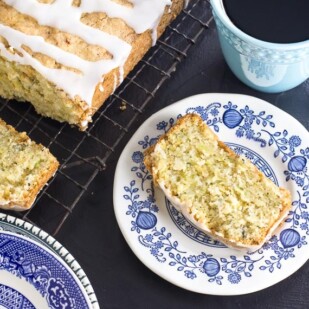
Low FODMAP Lemon Zucchini Bread
Low FODMAP Lemon Zucchini Bread can be prepared in the time to takes to preheat the oven. Grated zucchini and lots of very finely grated lemon zest are combined with basic quick bread ingredients like eggs, sugar, oil and our favorite low FODMAP gluten-free flour blend.
Low FODMAP Serving Size Info: Makes 1, 8-inch (20 cm) loaf; 12 slices; serving size 1 slice
Ingredients:
Lemon Zucchini Bread:
- 1 1/3 cups (194 g) low FODMAP gluten-free all-purpose flour, such as Bob Red Mill’s 1 to 1 Gluten Free Baking Flour
- 1/2 teaspoon baking soda
- 1/4 teaspoon baking powder; use gluten-free if following a gluten-free diet
- 1/4 teaspoon salt
- 4- ounces (115 g) finely shredded unpeeled zucchini
- 3/4 cup (149 g) sugar
- 1/4 cup (60 ml) neutral vegetable oil, such as canola, vegetable or rice bran
- 1 large egg, at room temperature
- 2 tablespoons freshly squeezed lemon juice
- Zest of 2 lemons
Glaze:
- 1/2 cup (45 g) sifted confectioners’ sugar
- 1 tablespoon freshly squeezed lemon juice
Preparation:
-
For the Bread: Position rack in middle of oven. Preheat oven to 350°F (180°C). Coat the inside of an 8-inch by 4-inch (20 cm by 10 cm) loaf pan with nonstick spray, then line bottom with parchment paper, allowing over-hang on both sides. Spray the parchment.
-
In a large mixing bowl combine flour, baking soda, baking powder and salt to aerate and combine. Make a well in the center; set aside.
-
In a separate mixing bowl combine zucchini, sugar, oil, egg, lemon juice, and lemon zest. Whisk to combine.
-
Pour wet ingredients over the dry and use a stir and fold action to mix just until combined. Scrape batter into prepared pan.
-
Bake for 40 to 45 minutes or until light golden brown and a bamboo skewer inserted in the center comes out clean. Cool in pan on a wire rack until just warm, then remove from pan, peel away parchment and cool completely.
-
For the Glaze: Whisk together the confectioners’ sugar and lemon juice and drizzle over cooled bread. Bread is ready to eat or may be stored in an airtight container at room temperature for up to 3 days.
Notes:
Tips
FODMAP Information
Our recipes are based on Monash University and FODMAP Friendly science.
- Eggs: Eggs are high in protein and do not contain carbohydrates, according to Monash University.
- Lemon Juice: Monash University has lab tested lemon juice and it is low FODMAP in 1/2 cup (125 g) amounts.
- Oil: All pure oils are fats and contain no carbohydrates, therefore they contain no FODMAPs.
- Sugar: Monash University and FODMAP Friendly have both lab tested white, granulated sugar. Monash states that a Green Light low FODMAP serving size of white sugar is 1/4 cup (50 g). FODMAP Friendly simply states that they have tested 1 tablespoon and that it is low FODMAP. Regular granulated white sugar is sucrose, which is a disaccharide made up of equal parts glucose and fructose. Sucrose is broken down and absorbed efficiently in the small intestine.
- Zucchini: Both Monash University and FODMAP Friendly have lab tested zucchini (also called marrow). FODMAP Friendly gives it a “Pass” at 1/2 cup (75 g) portions. Monash lists 1/3 cup and 65 g as low FODMAP, showing it to be Moderate for fructans in portions of ½ cup (75 g).
Please always refer to the Monash University & FODMAP Friendly smartphone apps for the most up-to-date lab tested information. As always, your tolerance is what counts; please eat accordingly. The ultimate goal of the low FODMAP diet is to eat as broadly as possible, without triggering symptoms, for the healthiest microbiome.